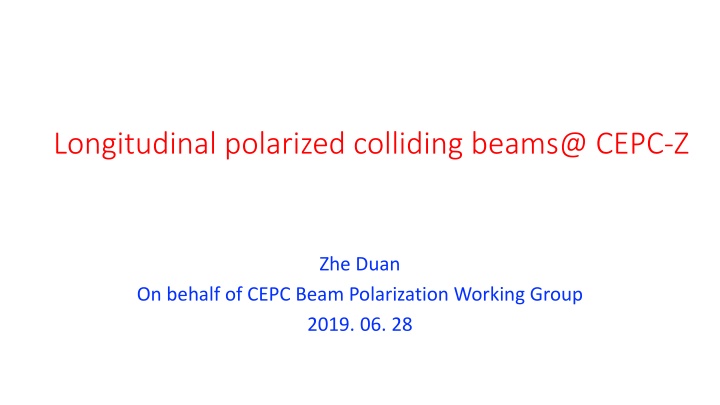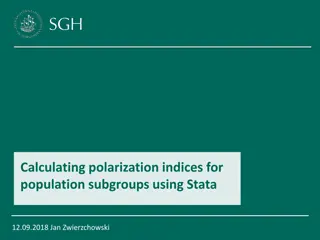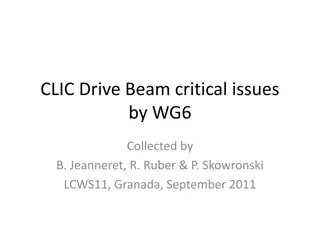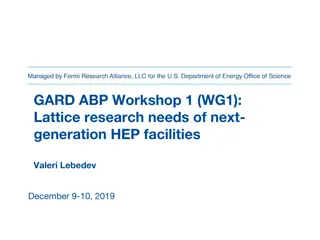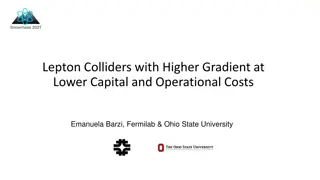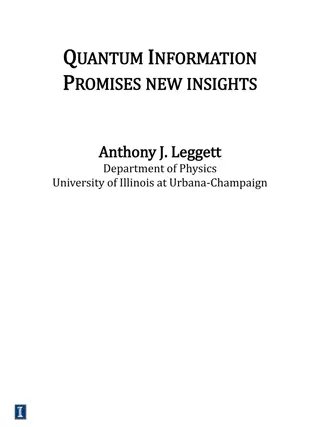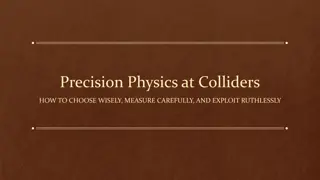Achieving High Average Beam Polarization in Particle Colliders
Detailed discussion on achieving high average beam polarization in particle colliders like CEPC, focusing on longitudinal polarized colliding beams, beam polarization requirements, basic formulas, and strategies for maintaining beam polarization during physics runs. Emphasis on scenarios involving self-polarization and polarized injected beams for optimizing luminosity. Insights shared on beam polarization evolution, top-up injection, and methods to enhance beam polarization efficiency.
Download Presentation

Please find below an Image/Link to download the presentation.
The content on the website is provided AS IS for your information and personal use only. It may not be sold, licensed, or shared on other websites without obtaining consent from the author.If you encounter any issues during the download, it is possible that the publisher has removed the file from their server.
You are allowed to download the files provided on this website for personal or commercial use, subject to the condition that they are used lawfully. All files are the property of their respective owners.
The content on the website is provided AS IS for your information and personal use only. It may not be sold, licensed, or shared on other websites without obtaining consent from the author.
E N D
Presentation Transcript
Longitudinal polarized colliding beams@ CEPC-Z Zhe Duan On behalf of CEPC Beam Polarization Working Group 2019. 06. 28
Requirements of longitudinal beam polarization Figure of merit: Luminosity * f( Pe+, Pe-) Typically, longitudinal beam polarization > 50% @IPs is required Polarization of one or both beams is OK for some measurements Polarization of both beams is required for some other measurements Not interesting if luminosity loss is too high
Some basic formulas of beam polarization Beam polarization evolution in an electron storage ring between injections 1 1 1 92% ? ? = ?ens,DK1 ? ?/?DK + ?0? ?/?DK, ???= ????+ ?dep, ?ens,DK 1+????/?dep
Beam polarization in CEPC Collider Rings Top-up injection (continuous injection) is baseline to maintain a high average luminosity Average beam polarization for continuous injection during physics runs Injected beam polarization Self-polarization: equilibrium beam polarization in the ring ?ens,DK 1 + ?DK/?b ?0 ?avg= + 1 + ?b/?DK Competition between beam decay/injection and polarization build-up in the ring @CEPC-Z: ?ens,DK > 50%, ?DK > 100 hour, ?b= 2~3 hour, ?DK ?b The first term is by default negligibly low.
How to achieve a high average beam polarization ? Scenario 1: self-polarization + unpolarized injected beam Mandatory to make ?DK ~ ?b ?DKcan be reduced down to ~ 10 hours, with asymmetric wiggler, limited by allowed energy spread increase ?bis dominated by radiative Bhabha & beamstrahlung, increase in ?b-> loss in luminosity Significant loss in luminosity makes this scenario uninteresting, according to FCC-ee CDR A. Blondel, talk on FCC Week 2017
How to achieve a high average beam polarization ? Scenario 2: polarized injected beam ?ens,DK 1+?DK/?b+ ?0 ?avg= 1+?b/?DK ?0, given that ?DK ?b A high average beam polarization is not in direct contradiction to a high luminosity! Tasks: Preparation of polarized beam in the injector (AGS, RHIC) Design of spin rotators in the collider rings (LEP, HERA, SuperB, SuperT-C, RHIC) Ensure ?DK ?b via spin matching (LEP, HERA) This scenario is not considered in FCC-ee CDR, and we can make a difference @ CEPC
Longitudinal polarized e- beam preparation in CEPC Longitudinal polarization in source & linac Polarized electron source is a matured technology, polarization ~ 90% and nC-level bunch charge is achievable Siberian snake Siberian snake is necessary in the booster to maintain a decent polarization Spin rotators Spin rotators are necessary in the collider ring to make the polarization along longitudinal direction @ IPs.
Maintenance of beam polarization in the booster First calculations show the beam polarization can be well maintained through acceleration to 45.5 GeV, with the help of one Siberian snake. Design study of the Siberian snake is under way, series of solenoid magnets is a tentative option. Remaining beam polarization after crossing one spin resonance Siberian snake
What about polarized e+ beam?? Polarized e+ source is still technically challenging ILC polarized e+ source requires an e- drive beam > 100 GeV, not available @ CEPC-Z (ILC TDR, 2013) PEPPo experiment @ Jlab demonstrated (E. Voutier, arXiv 1711.09659) polarized e+ beam: 10 5~10 3 flux, 75% polarization of driving polarized e- beam We propose an idea of e+ polarizing ring to produce highly polarized e+ beams.
Polarized e+ beam preparation in the CEPC injector Courtesy of Meng C. Electron gun Siberian snake Siberian snake is necessary in the booster to maintain a decent polarization through acceleration Replace the e+ damping ring by a e+ polarizing ring
Positron polarizing ring Tentative parameters An asymmetric wiggler @BESSY-II as WLS, A. M. Batrakov, et al., APAC 2001, pp251-253. RF cavity Injection Wigglers Wigglers Extraction RF cavity Using superconducting asymmetric wigglers to boost self-polarization to ~ 20 second e+ beam stays in the ring for ~ 20 second to gain > 50% beam polarization before extraction Key hardware challenge: 15 Tesla dipole magnet, in line with R&D efforts for SppC
Compatibility with top-up injection of collider rings CEPC baseline top-up injection timing: 438 second 275.2 second CEPC top-up injection timing w/ e+ polarizing ring Injection Extraction Injection Injection Extraction e+ polarizing ring Store 20 s Store 20 s e+ 6 s e- 6s e+ 6s e- 6s e- 6s e+ 6s e+ 6s Electron gun Booster 8 s 8 s 8 s 8 s
Evolution of e+ polarization in the collider ring Initial injection of unpolarized beam Top-up injection of polarized beam
Key R&D items At the moment, we ll focus on the accelerator physics study & design of polarized colliding beams, to give parameter specs. for harewares Siberian snake in the booster Spin rotators in the storage ring Lattice design & beam dynamics issues of e+ polarizing ring Related hardwares Polarized electron gun Longitudinal polarimeter Siberian snake & spin rotator High field asymmetric wigglers
Backup What about higher CM energy? More challenging to maintain beam polarization in the booster: stronger spin resonances, longer snakes More challenging to ensure ?DK ?b as depolarization is more severe at higher energy Scaling of asymmetric wiggler parameters Polarization build-up time ~ 1/ (E^2 B+^3 L) Energy loss per turn ~ E^2 B+^2 L What if booster is replaced by plasma acceleration?
